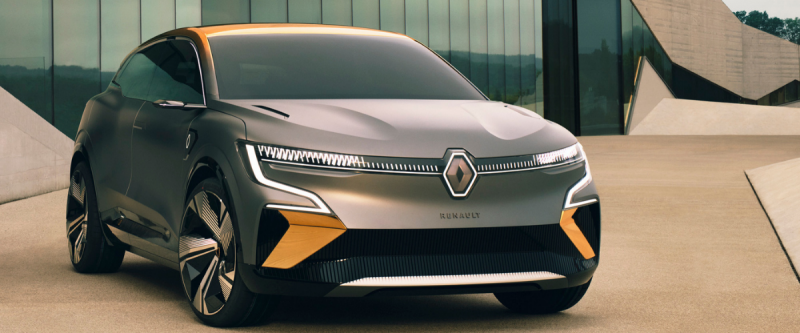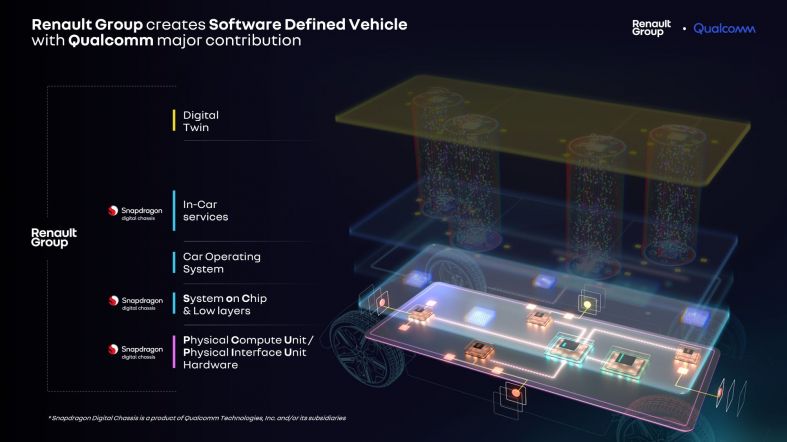Qualcomm Technologies and Renault Group to Jointly Develop a Centralized, Software-Defined Vehicle Architecture for the Automaker's Future Electric Models
【Summary】Qualcomm Technologies is working Renault Group’s new software company Ampere on the co-development of a centralized compute architecture for the automaker's next-generation of software defined vehicles, which will be fully connected and capable of receiving regular over-the-air (OTA) software updates. The ‘Software-Defined Vehicle (SDV) Platform for Renault’s future electric vehicles will be based on Qualcomm’s Snapdragon family of digital chassis solutions.

Electronics and chip manufacturer Qualcomm Technologies continues its push into the automotive hardware space as modern vehicles become more like rolling smartphones powered by software. As a result, chip makers and hardware developers including Qualcomm Technologies, Nvidia and Intel Corp are becoming key suppliers to automakers.
On Tuesday, Qualcomm announced its is working with Renault Group's new software company Ampere on the co-development of a centralized compute architecture for Renault's next-generation of software defined vehicles, which will be fully connected and capable of receiving regular over-the-air (OTA) software updates.
These ‘Software-Defined Vehicle (SDV) Platforms for Renault's future electric vehicles will be based on Qualcomm's Snapdragon family of digital chassis solutions. The two partners plan to deliver next-generation SDV architecture to address the evolving needs and requirements of modern vehicles. The SDV platform supports a digital cockpit, connectivity, advanced driver assistance systems (ADAS) and other functions.
As part of the collaboration, Qualcomm or one of its affiliates, will also be investing in Renault's dedicated electric and software company Ampere.
"Renault Group is strengthening its strategic collaboration with Qualcomm Technologies, a major mobile and automotive technology player, to bring the first open and horizontal Software Defined Vehicle platform to the automotive market," said Luca de Meo, CEO Renault Group.
Starting in 2026, Renault vehicles will utilize the SDV platform, including new generations of the Snapdragon Digital Chassis, designed to power new Android cockpits, which will provide immersive 3D graphics.
More notably, the SDV platform will also centralize other vehicle functions, including advanced driver assistance (ADAS), body, chassis, telematics, connectivity, Power Line Communications (PLC) and cybersecurity. This software-based platform will allow Renault to optimize hardware and software costs, allowing connection to a vehicle's Physical Interface Unit (PIU), which serves as an interface with the vehicle's actuators.
The SDV architecture is designed to be open to other vehicle manufacturers.
Renault has been working with Qualcomm since 2018. The automaker featured Qualcomm's Snapdragon cockpit platform in the Renault Megane E-Tech Electric's OpenR Link multimedia system.
The OpenR link connectivity features offer an always up to date, intelligent driver interface that delivers in-car experiences to both drivers and passengers. It also features built-in services from Google, such as Maps and a voice-powered Assistant.
"Qualcomm is very proud of its relationship with the Renault Group and the expansion of our collaboration to jointly define the car of the future with leading semiconductors, software and services. We are thrilled to have our Snapdragon Digital Chassis solutions play a pivotal role in ushering in their next generation of software-defined vehicles and help accelerate the digital transformation of the automobile," said Cristiano Amon, President and CEO, of Qualcomm.
Automaker Volkswagen is also working with Qualcomm. In June, the automaker's software unit CARAID announced it has selected Qualcomm Technologies to supply system-on-chips (SoCs) for its vehicle software platform designed to deliver up to SAE level-4 autonomous driving capabilities in the automaker's future vehicles.
The Qualcomm's Snapdragon Ride Platform meets the needs of the software developed by CARIAD, according to Volkswagen.
Qualcomm's Snapdragon Ride platform was first announced at CES in Jan 2020. Since its unveiling, it has steadily gained momentum with global automakers and Tier 1 suppliers worldwide as more vehicles are being equipped with connectivity features and automated driving capability.

The Snapdragon Ride Platform is based on Qualcomm's Snapdragon family of automotive SoCs. It's built on scalable and modular high-performance multi-core CPUs. The platform also utilizes energy efficient AI and computer vision (CV) engines, as well as a graphics processing unit (GPU). The chips support level 2 driver assist systems, such as adaptive cruise control, automatic emergency braking (AEB) and lane keep assist.
Snapdragon Ride is also fully customizable and allows automakers to add advanced safety features, including autonomous driving capabilities, to their models. It allows an automaker to select which high-performance computer chips are used and match them with its own vehicle software requirements.
In Dec 2021, BMW announced its will use Qualcomm's Snapdragon Ride platform to support the advanced driver assist systems (ADAS) and autonomous driving features of future software-defined vehicles.
BMW's next generation autonomous driving stack will be based on Qualcomm's Snapdragon Ride vision system-on-chip (SoC). It supports vision perception and ADAS central compute SoC controllers managed by Qualcomm's Car-2-Cloud services platform.
BMW said it will utilize Qualcomm's SoCs and hardware to support a wide variety of ADAS and autonomous driving functions, including front, rear and surround view camera computer vision with a dedicated computer vision SoC, as well as a high-performance ADAS central compute controller for autonomous driving.
Qualcomm's hardware solution for automakers also includes communications solutions for EV charging. In June, Qualcomm announced its next-generation powerline communication (PLC) device called the "QCA7006AQ". The PLC device is based on Qualcomm's QCA700X family of products, which are widely used for the on-board charging units in EVs and charging stations across the globe.
The QCA7006AQ device is designed to address the needs for electric vehicle (EV) charging station communications or electric vehicle supply equipment (EVSE) using the global Combined Charging System (CCS) plug.
PLC technology allows for data communication over power lines. By using a power line as a communication network, it is possible to build a low-cost bidirectional communication system, which makes its easier to scale the technology at public EV charging stations.
-


Ford is Testing a New Robotic Charging Station to Assist Drivers of EVs With Disabilities
-


Ford Raises the Prices of the F-150 Lightning Electric Pickup Due to Rising Raw Material Costs
-


The BMW 7-Series to Feature HD Live Maps From HERE Technologies for Hands-Free Highway Driving in North America at Speeds up to 80 MPH
-


AutoX to Use the 'Eyeonic Vision Sensor' from California-based SiLC Technologies for its Robotaxi Fleet in China
-


LG Develops ‘Invisible’ Speaker Sound Technology That Could Revolutionize In-Vehicle Audio
-


Researchers at South Korea’s Chung-Ang University Develop a ‘Meta-Reinforcement’ Machine Learning Algorithm for Traffic Lights to Improve Vehicle Throughput
-


Zeekr’s New 009 Electric Passenger Van is the World’s First EV to Feature CATL’s Advanced ‘Qilin’ Battery With a Range of 510 Miles
-


Redwood Materials is Building an Electric Vehicle Battery Recycling Facility in South Carolina
- China Has Installed Around 4.7 Million Electric Vehicle Charging Poles as of October 2022
- Prices For Used EVs Continue to Rise as Gas Cars Drop
- Ford is Testing a New Robotic Charging Station to Assist Drivers of EVs With Disabilities
- Toyota’s Redesigned Prius May Get More Drivers Behind the Wheel of a Hybrid Vehicle
- GM Offering to Buy Out Buick Dealers That Don’t Want to Sell EVs
- Michigan-based May Mobility Closes on $111 Million Funding Round, Begins Development on Toyota’s Next-Gen Commercial Autonomous Vehicle Platform
- The Tesla Model Y and Model 3 Take the 1st and 2nd Place Spots in the Annual Cars.com ‘American-Made Index’
- Volkswagen’s Software Unit CARIAD to Co-Develop a System-on-Chip With STMicroelectronics for the Automaker’s Future Software-defined Vehicles
- GM Expanding First Responder Training Program for EV Crashes
- Volvo Cars and Epic Games to Partner on a High-Resolution 3D Digital Driver’s Display Powered by the Unreal Engine











 About Us
About Us Contact Us
Contact Us Careers
Careers